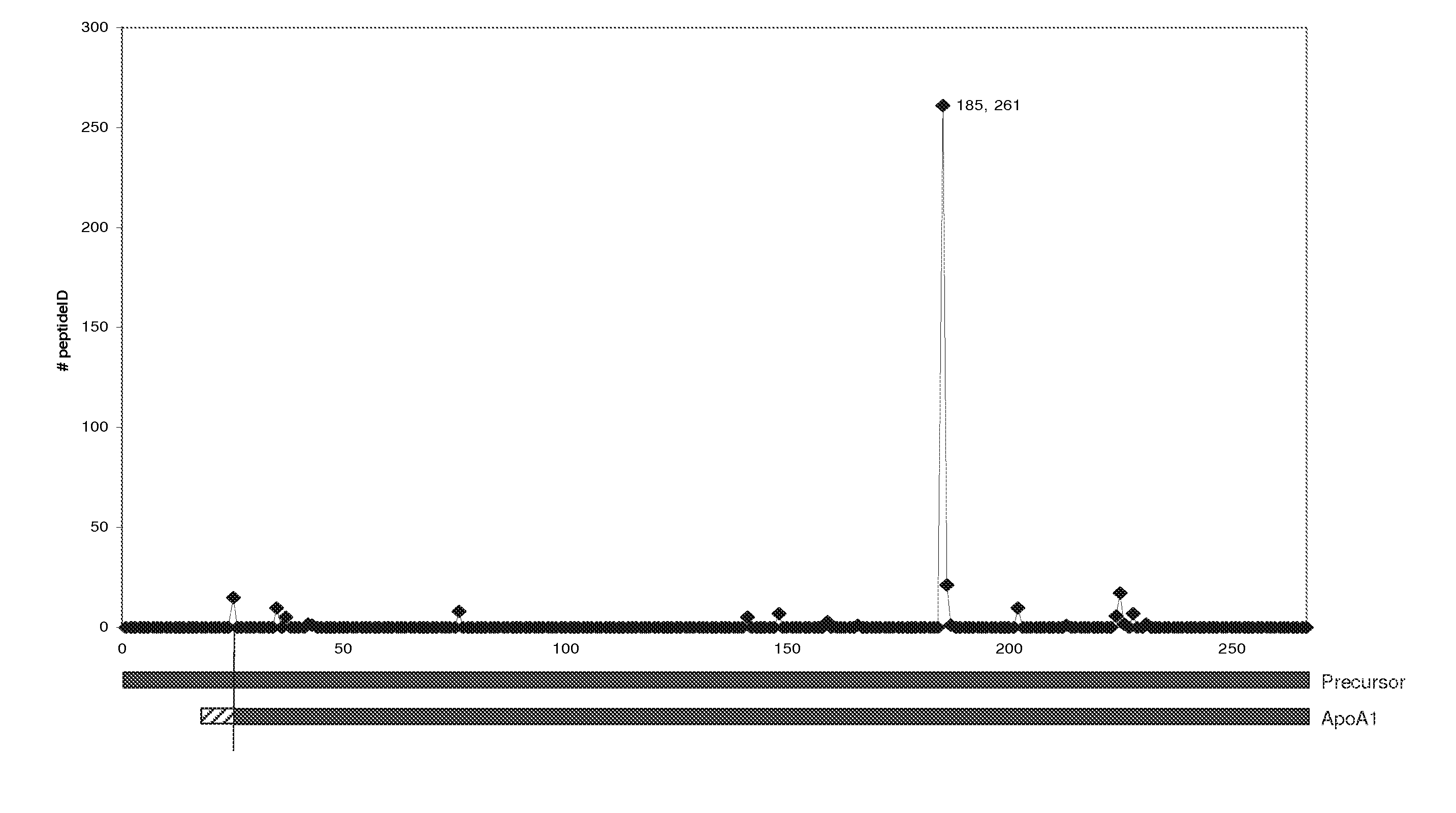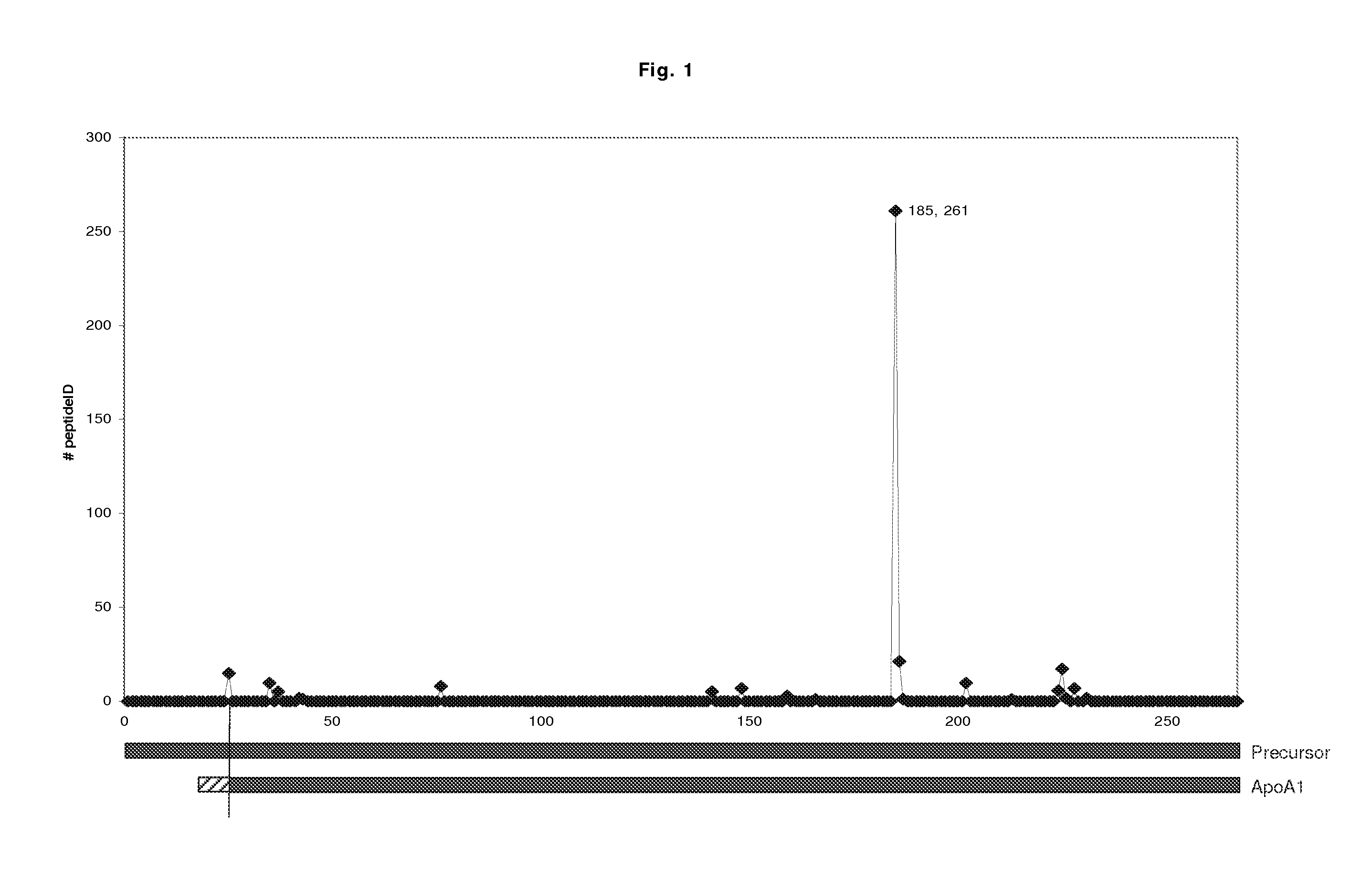Protease-sensitive site in apolipoprotein a1, therapeutic and diagnostic implications
a protease-sensitive, apolipoprotein technology, applied in the field of hdl-related lipid metabolism involving apolipoprotein a1, can solve the problems of low level of hdl-cholesterol, high risk of atherosclerosis, complex process of rct, etc., to improve the inverted cholesterol transport, improve the cholesterol balance, and improve the effect of cholesterol
- Summary
- Abstract
- Description
- Claims
- Application Information
AI Technical Summary
Benefits of technology
Problems solved by technology
Method used
Image
Examples
example 1
N-Terminal Analysis to Detect ApoA1 Processing
[0097]The COFRADIC N-terminal proteomics platform allows us to specifically analyse the N-terminus of a protein (or of a number of proteins), but in addition application of such a strategy also reveals proteolytic processing as these novel N-termini are also readily detected. Application of this platform on a serum sample revealed the occurrence of a novel cleavage event in human Apolipoprotein A1 (Swissprot accession: APOA1_HUMAN) after position R184.
Protocol:
Delipidation and Affinity Removal of 6 Abundant Proteins
[0098]Serum from a healthy volunteer was prepared according to standard procedures. One volume of TBS (100 mM Tris-HCl ph7.4, 150 mM NaCl) and one volume of trichlorotrifluoroethane (Riedel-de-Haën, #34874) are added to a 120 μl serum sample. After vortexing and centrifugation, the delipidated sample is transferred to a new vial and diluted 2.5× with MARS buffer A complemented with protease inhibitors. The sample is depleted w...
example 2a
Western Analysis for ApoA1 Variants in Blood of a Healthy Person
[0105]Using antibodies directed against the N- and C-terminus of ApoA1 in Western analysis, we are able to identify the naturally occurring variants of this protein that can be found in the blood of a normal healthy person. This confirms the data obtained with the N-terminal discovery platform described higher.
Protocol:
[0106]Serum samples from healthy donors (appr. 2 μl or 100 mg) are diluted to 16 ul with Phosphate Buffered Saline (0.2M Phosphate pH7.4, 150 mM NaCl). 4 μl 5× Loading buffer is added (0.313 M Tris-HCl pH 6.8, 10% SDS, 0.05% bromophenol blue, 50% glycerol). The sample is heated to 99° C., and after cooling loaded on 15% SDS-PAGE gels (Biorad, Tris-HCl ready gel). After separation, the protein material is transferred to Immobilon-PSQ (Millipore) membranes by electroblotting. Membranes are subsequently blocked by milk powder (2%) dissolved in TBS-T (100 mM Tris-HCl pH7.4; 150 mM NaCl; 1 / 1000 Tween20) for 30...
example 2b
Immunological Detection of the C-Terminal Fragment in ApoA-1
[0108]As an alternative detection system to show processing of ApoA-1, we used a classic immunological approach. The AI-4.1 mouse monoclonal antibody detects specifically the ApoA-1 sequence and was obtained by immunization of BALB / c mice with the C-terminal fragment of ApoA-1 obtained after cyanogen bromide cleavage of the protein (Allan C. et al., 1993, Biochem J, 290, 449-455). This fragment corresponds to amino acid sequence 173-267 of the full length ApoA-1 protein. Processing in ApoA-1 occurs at position R184. The size predicted for the C-terminal fragment based on this cleavage is 9.3 kDa.
[0109]Serum obtained from healthy males was pooled and depleted using the Multiple Affinity Removal System (MARS) level I (Agilent) removing the 6 most abundant proteins (albumin, alfa-1-antitrypsin, haptoglobin, IgG, IgA, transferrin). 3× Loading buffer (125 mM Tris-HCl / 4% SDS / 50% glycerol / 0.02% Bromophenol Blue / 10% beta mercaptoet...
PUM
| Property | Measurement | Unit |
|---|---|---|
| Electrical resistance | aaaaa | aaaaa |
| Efficiency | aaaaa | aaaaa |
Abstract
Description
Claims
Application Information
 Login to View More
Login to View More - R&D
- Intellectual Property
- Life Sciences
- Materials
- Tech Scout
- Unparalleled Data Quality
- Higher Quality Content
- 60% Fewer Hallucinations
Browse by: Latest US Patents, China's latest patents, Technical Efficacy Thesaurus, Application Domain, Technology Topic, Popular Technical Reports.
© 2025 PatSnap. All rights reserved.Legal|Privacy policy|Modern Slavery Act Transparency Statement|Sitemap|About US| Contact US: help@patsnap.com



